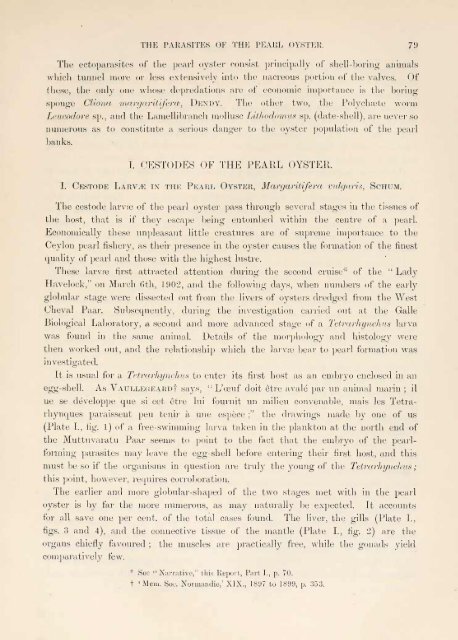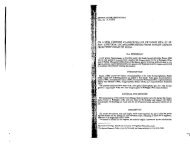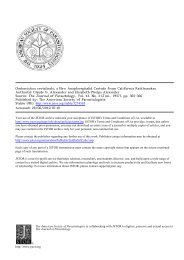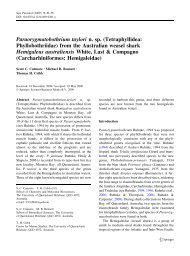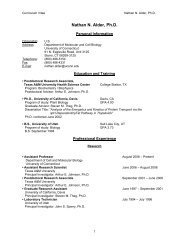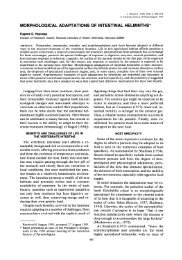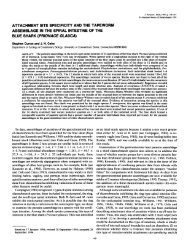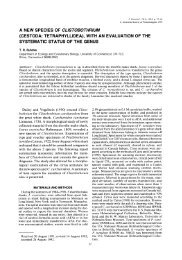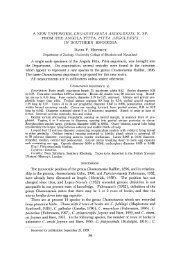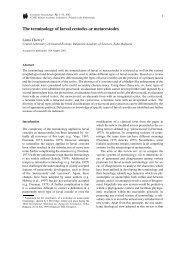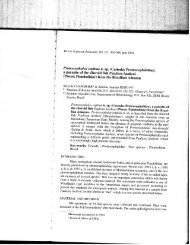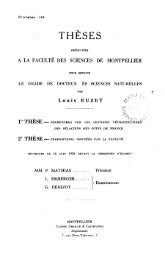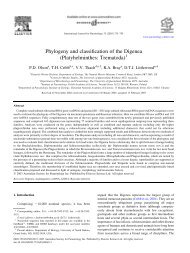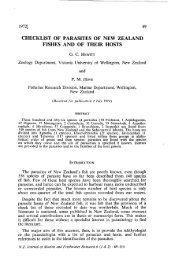PEARL OYSTER FISHERIES MARINE BIOLOGY OF CEYLON,
PEARL OYSTER FISHERIES MARINE BIOLOGY OF CEYLON,
PEARL OYSTER FISHERIES MARINE BIOLOGY OF CEYLON,
Create successful ePaper yourself
Turn your PDF publications into a flip-book with our unique Google optimized e-Paper software.
THE PARASITES <strong>OF</strong> THE <strong>PEARL</strong> <strong>OYSTER</strong>. 79The ectoparasites of the pearl oyster consist principally of shell-boring animalswhich tunnel more or less extensively into the nacreous portion of the valves. Ofthese, the only one whose depredationsare of economic importanceis the boringsponge Cliona niaiyart/ij'ertr,Dknmy. The other two, the Polychgete wormLeucodore sp.,and the Lamellibranch mollusc Lithodomus sp. (date-shell), are never sonumerous as to constitute a serious danger to the oyster population of the pearl1 i.inks.I. CESTODES <strong>OF</strong> THE <strong>PEARL</strong> <strong>OYSTER</strong>.I. Cestode Larv.e in the Pearl Oyster, Margaritifera vulgaris, Schtjm.The cestode larvse of the pearl oyster pass through several stagesin the tissues ofthe host, that is if they escape being entombed within the centre of a pearl.Economically these unpleasant little creatures are of supreme importance to theCeylon pearl fishery, as their presence in the oyster causes the formation of the finestquality of pearl and those with the highest lustre.These larvae first attracted attention during the second cruise'" of the " LadyHavelock," on March 6th, 1902, and the following clays,when numbers of the earlyglobular stage were dissected out from the livers of oysters dredged from the WestCheval Paar.Subsequently, during the investigation carried out at the GalleBiological Laboratory, a second and more advanced stage of a Tetrarhynchus larvawas found in the same animal. Details of the morphology and histology werethen worked out, and the relationship which the larvre bear to pearl formation wasinvestigated.It is usual for a Tetrarhynchus to enter its first host as an embryoenclosed in an' ;egg-shell. As VaullegeardI says, L'oeuf doit etre avale" par un animal marin ;ne se developpe que si cet etre lui fournit un milieu convenable, mais les Tetrarhynquesparaissent peu tenir a une espece ;" the drawings made by one of us(Plate I., fig. 1) of a free-swimming larva taken in the plankton at the north end ofthe Muttuvaratu Paar seems to point to the fact that the embryo of the pearlformingparasites may leave the egg-shell before entering their first host, and thismust be so if the organisms in question are truly the young of the Tetrarhynclnis ;this point, however, requires corroboration.The earlier and more globular-shaped of the two stages met with in the pearloyster is by far the more numerous, as may naturally be expected. It accountsfor all save one per cent, of the total cases found. The liver, the gills (Plate I.,figs. 3 and 4), and the connective tissue of the mantle (Plate I., fig. 2) are theorgans chiefly favoured ;the muscles are practically free, while the gonads yieldilcomparatively few. * See " Narrative," this Report, Part I., p. 70.t ' Mem. Soc. Normandie,' XIX., 1897 to 1899, p. 353.


